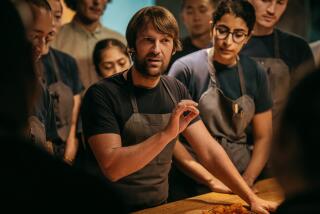Alex Atalaâs âD.O.M.â takes us to a marvelous world with edible ants, Brazilian sea snails
Restaurant cookbooks have often dabbled in the exotic -- techniques you and I canât equal, equipment we donât have, ingredients we canât find or afford. Those, after all, are the reasons we go to restaurants. Still, there was always a hint of the possible -- we could dream that if we would only sharpen up our knife skills or buy that Pacojet, these dishes would be within our grasp.
But in the last couple of years, chefs have begun exploring hyper-local cooking, using wild ingredients found by foragers and pushing the limits of exoticism beyond the point even the most ambitious of us could dream. In his âNomaâ cookbook a couple of years ago, Danish chef Rene Redzepi introduced his readers to ingredients so wild and so place-specific that even his neighbors would have trouble finding them. Hello, sea buckthorn and reindeer lichen.
Now in âD.O.M: Rediscovering Brazilian ingredients,â one of this yearâs most talked-about cookbooks, Alex Atala is doing the same thing in South America. Fish and shellfish weâve never heard of, like filhote and Brazilian sea snails. Vividly colored tropical fruits. Of course, the whole panoply of South American tubers -- true yams, baroa potatoes and mangaritos. And then the just plain odd (at least to us) -- Brazilians have a special affection for eating the saĂşva ant.
Being a modern chef, Atala prepares these foodstuffs using techniques youâll never find in the âJoy of Cooking.â He roasts fresh herbs until theyâre blackened and charred. He fries fish scales to add crunch. He even grinds those ants with seaweed and black salt to make a garnishing powder.
The effect is at the same time beautiful and oddly disconcerting. Itâs a little like visiting the jellyfish exhibit at an aquarium. On one level, the objects are otherworldly and exist in ways we can only guess at. They are also so gorgeous we can only marvel.
âD.O.M.â is a book that takes you outside of any relatable frame of reference and forces you to accept the dishes on their own terms. In that way, it is transporting. We leaf through pages of otherworldly Brazilian landscapes and portraits and then weâre confronted with something like an oyster topped with a shiny lozenge of sorbet made from cupuacu (an ancestor of the cocoa bean). We canât imagine how it might taste or how it might have been prepared. We are truly in another country.
ALSO:
Cookbook: Daniel Bouludâs culinary manifesto
Cookbook: Daniel Pattersonâs intellectual âCoiâ
Cookbook: David Kinchâs exquisitely natural âManresaâ
More to Read
Eat your way across L.A.
Get our weekly Tasting Notes newsletter for reviews, news and more.
You may occasionally receive promotional content from the Los Angeles Times.











